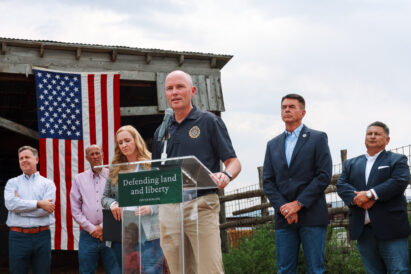Northern Utah cankerworm outbreak raises concern for tree health
- Cankerworm caterpillars crawl in the hand of Jerry Auble on Monday, June 13, 2022.
- This photo taken Wednesday, June 29, 2022, shows defoliated maples at The Oaks restaurant, currently closed, highlighting a pattern of foliage destruction as caterpillars creep down the Ogden Canyon.
- In this photo taken Friday, June 10, 2022, defoliated trees can be seen from the east of Trapper’s Loop Road, near the Snowbasin turnoff, showing the extent of gray patches where cankerworms have fed on springtime trees.
Throughout the past month or so, defoliation has been occurring to a degree that has not been seen in Northern Utah in about a dozen years.
The culprit? Creepy-crawler insects known as fall cankerworms, also commonly called inchworms.
Jerry Auble, a Utah certified, commercially licensed pest applicator and member of the International Society of Arboriculture, is a self-described tree doctor. He has focused on tree health care for the past seven years and discovered a sight that “took his breath away” last month.
“I first got into an area in the upper valley, down near where the (Huntsville) monastery is,” Auble said, “and it was raining hard, it was very cold. I was soaking wet from walking around in the trees trying to see what was going on. When I finally got a grasp of what was laid out before me, it was bone-chilling — literally hundreds of trees stripped of foliage.”
Auble realized as the fog lifted that the defoliation wasn’t as localized as he had expected; it was spreading across hillsides, up hilltops, reaching down canyons. And it isn’t just trees in Weber County being affected. Evidence of the caterpillar’s carnage is scattered all the way across Trapper’s Loop and well into Morgan County.
There are about six weeks of the year during which fall cankerworms do the most damage to trees, Auble said. And because these bugs’ life cycles are seasonal, the damage is already done this spring. However, according to Marion Murray, an integrated pest management specialist at Utah State University, the last time defoliation to this degree was seen due to these insects was 2007 to 2009.
“Because it is a native species, it goes through cycles of a peak period of activity where there may be outbreaks that last one to three years,” Murray said. “Eventually, the other native insect pathogens or predators that have coevolved will bring the population back down, and then it won’t be an issue for about five to 10 years.”
When these fall cankerworms are in their larval stage, they move from tree to tree and area to area in a process called “ballooning.” They can move miles on the wind, according to Auble.
There is one generation per year, which hatches from eggs that were laid on the tree the previous fall. They hatch in rhythm when the trees start to bloom, then begin to feed on the trees. The bugs feed for anywhere from four to six weeks, depending on the outdoor temperature.
By mid-June, they are typically fully developed and drop to the ground, dig into the soil and begin to pupate, staying in that form until about the first or second frost the following fall. The female moths, which are wingless, crawl up the trees and the males fly up to mate. Each female can lay up to 100 eggs.
The larval caterpillars feed on just about all the native trees in the area, from scrub oak to elms. The environment is like a smorgasbord for them in more rural areas, according to Auble.
“Within a month or so, you hardly knew that there was this outbreak of fall cankerworm,” Murray said, recalling her experience with the 2007-2009 outbreak, “Climate change and drought conditions make it harder for the trees to refoliate. Trees take a lot of energy to refoliate their full canopy of leaves, and not having enough water, especially being defoliated a few years in a row, could eventually cause tree death.”
Drought conditions will make it much more difficult for trees to refoliate and regain their health, which could, potentially, cause fire concerns in the upcoming spring and summer seasons for the next few years.
“Typically, we don’t think of the insect itself being affected by drought conditions, it is more the trees,” Murray said. “So, the insect occurrence is more a natural cyclical pattern that, for the most part, is not so much to do with drought but more affected by winter conditions and spring conditions, so temperatures.”
If the fall cankerworm is seen in 2023, especially in the more urban areas, everyday backyard gardeners can apply Bacillus thuringiensis, an organic insecticide specific to all caterpillars, commonly called “Bt,” which according to Murray is an effective control against fall cankerworms.
“It’s up to Mother Nature at this point,” Auble said. “I am pessimistic, I suppose, and we’ll have to be on the lookout for fall cankerworms next spring before they start showing up in people’s backyards.”
The public can stay up to date on insect and pest issues during the summer months by signing up for Utah State University’s Pest Advisory Newsletter at https://pestadvisories.usu.edu.









